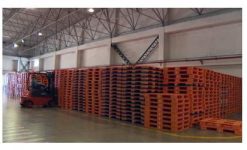
RFID pallet logistics transportation opens the door to “smart logistics”
[ad_1]
With the rapid development of warehousing and logistics, the number of items managed by the warehouse is increasing, the number of times of entering and leaving the warehouse is frequent, and the warehouse management operation has become very complicated and diversified. The traditional manual warehouse operation mode and data collection method have been unable to meet the requirements of modern warehouse management. . Need to make fast and accurate requirements. Since the introduction of “carrying with pallet”, the popularization of standardized pallets has been accelerated. RFID technology performs intelligent automatic identification and collection of information, and RFID pallet logistics transportation opens the door to “smart logistics”.
With the addition of RFID technology, the door to a new world of “smart logistics” has been opened. The combination of RFID technology and pallets not only facilitates real-time tracking and management of the circulation and use of the pallets themselves, such as: leasing, recycling, maintenance, storage, etc. In addition, it also realizes the visual monitoring of pallet loading, which greatly promotes the automation level of information collection in logistics management, ensures the safety of goods in the transportation process, improves logistics efficiency and reduces costs.

What is “consignment”?
“Tacked transportation” refers to a transportation method in which goods are assembled on a standard pallet according to certain requirements to form a transportation unit and facilitate the use of forklifts or pallet elevators for loading, unloading, consignment, and storage. “Consignment with pallet” has become one of the three intermodal transportation methods recognized globally that go hand-in-hand with container transportation and barge transportation. According to surveys, 80% of the merchandise trade in the United States is carried by pallets, while over 80% of the EU merchandise trade is carried by pallets, and Japan has reached 77%.
At present, my country’s standardized pallets total 316 million, and 17 million leased pallets, a year-on-year increase of 16.4%. The growth rate is fast and the room for growth is broad. Guangdong Province is a major logistics province. In 2016, the total social logistics of Guangdong Province was 19,72.469.5 billion yuan, accounting for 8.6% of the country’s total; the total social logistics cost was 1,177.395 billion yuan, and the total logistics cost accounted for 14.81% of GDP. Through standardization, leasing and sharing of pallets, logistics costs can be effectively reduced.
It can be seen that the road to pallet standardization is irreversible, and the development of pallet leasing is also advancing at the same time, and pallet sharing is more in line with the requirements of the times. By revitalizing the social inventory of logistics vehicles, using the sharing economy as the guideline, connecting the resources of pallet manufacturers, pallet renters, logistics companies, and manufacturers, providing a collaborative and cooperative development opportunity for win-win development, reducing costs and increasing efficiency There is a very broad space for development.
RFID technology gives the world’s only “identity card” information to standardized pallets, realizes the entrance of pallet information units, greatly improves the synergy efficiency of the supply chain, and is an important technical means to promote the innovation of the modernized supply chain. In the pallet management, the pallet can be reused, and the RFID electronic tag can also be read and written repeatedly, which greatly reduces the cost. The electronic label on the pallet records the item code of the pallet, and the important information related to the name, quantity, volume, weight, shipping address, and receiving address of the goods on the pallet is stored in the database through the network. During the transportation from the departure place to the destination, the RFID tag can be read through the UHF RFID reader, retrieve the required information at any time, and upload the pallet and the location information of the arrival of the loaded goods.
It can be seen that through the combination of RFID technology and pallet management, it is possible to directly track the goods, ensure the safety of the goods, and effectively solve the pallet tracking. RFID technology realizes the intelligentization of pallet positioning, recycling, management, and settlement, reducing operating costs; promoting the development of “Internet +” efficient logistics; accelerating the formation of an open, shared, efficient and convenient smart logistics new ecology. The logistics warehousing management system uses RFID technology to automatically collect information about items, upload the collected data to the back-end system, and automatically identify the information of each link in the supply chain. The Internet of Things based on RFID will fundamentally change the management level of flow monitoring in all aspects of production, transportation, warehousing, etc. within the scope of global logistics and warehousing.
[ad_2]



